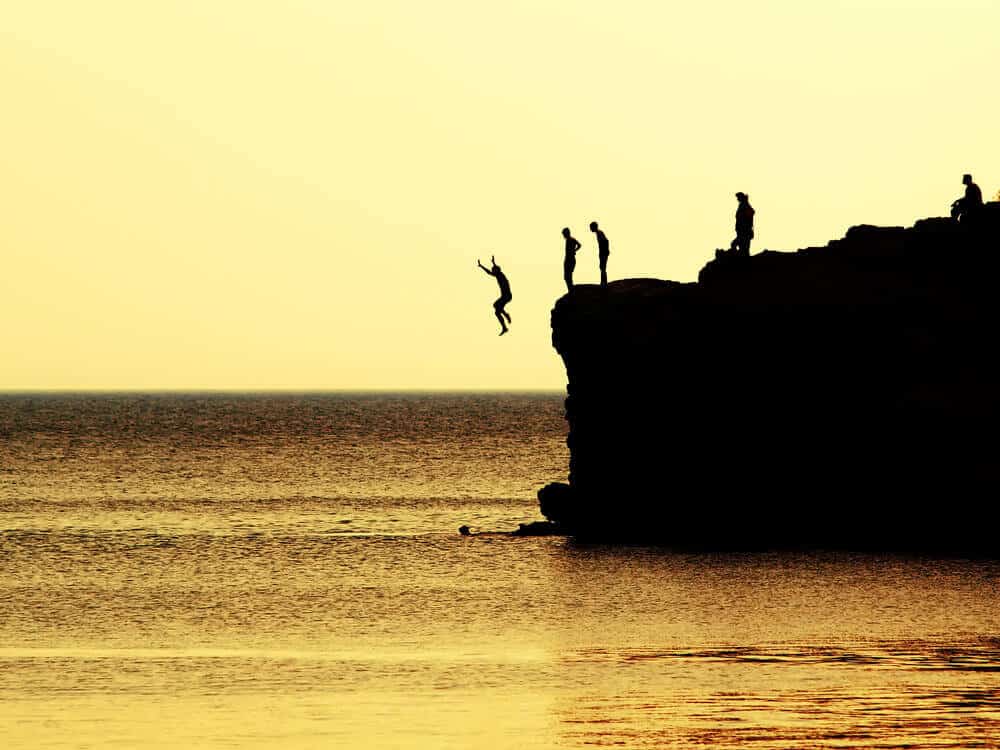Pushing the limits is one way to get a rush in life. For some, that means engaging in dangerous hobbies.
While some live for the thrill of dangerous hobbies, others find them to be nothing more than a death wish. Unfortunately, dangerous pursuits can lead to severe injury or even death. According to the National Safety Council, participating in dangerous hobbies is one of the leading causes of death in the United States.
Why Participate In Dangerous Hobbies
Bungee jumping without a proper safety harness, base jumping without a parachute, sky diving without a parachute, cave diving without an oxygen tank, big wave surfing without a life vest, and motorcycle racing without protective gear; why?
Simply put, the thrill leads us all to pursue dangerous things. Our body releases chemicals that feel good, which can be very addictive.
Dopamine is often referred to as the “reward hormone.” It’s released when we do something that feels good, such as eating our favourite food or winning a game. Some people chase this feeling by participating in dangerous hobbies. They get a rush from doing something that could potentially harm them. The riskier the leisure pursuit, the more dopamine is released.
This need for dopamine can lead to people taking more significant risks to get the same feeling of pleasure. Over time, the need for dopamine can become an addiction and be very difficult to break.
Another type of hormone released when we participate in activities we enjoy is endorphins. They are sometimes referred to as the “feel-good” hormones because they produce a sense of euphoria. Like dopamine, endorphins can be addictive. For example, people who participate in dangerous hobbies often do so because they crave the feeling of euphoria that comes with it.
Next is the neurotransmitter Serotonin, which plays a role in regulating our mood. Whenever we do something that makes us happy, Serotonin is released, leading to feelings of happiness and contentment. For example, people who participate in dangerous hobbies may do so as they are seeking out the feeling of happiness that it brings.
Adrenaline is released when we are in danger or feeling stressed. Adrenaline is helpful in dangerous situations as it gives us a burst of energy and makes us more alert to keep us safe.
The thrill of the risk and the reward of achieving the goal, overcoming fears and perceived inner weaknesses, the flow of hormones and resultant emotions motivate the participation in dangerous hobbies.
How to Stay Safe While Enjoying Dangerous Hobbies
While some thrive on the excitement of an adventure, others
consider these dangerous hobbies, and they can be enjoyed safely if the proper precautions are taken.
However, even with the proper safety measures, accidents can still happen. That’s why it’s essential always to use caution and good judgement when participating in any dangerous hobby.
While there’s no guarantee that you’ll never get hurt while participating in a dangerous hobby, there are some things you can do to reduce your risk of injury.
1. Follow all safety protocols. This means using the proper safety gear and following all rules and regulations. Dangerous hobbies are only safe if they’re done correctly.
2. Be mindful and aware of your surroundings, knowing your limits. If you’re not comfortable with something, don’t do it. It’s better to be safe than sorry.
3. Having a backup plan in case something goes wrong is wise. For example, if you’re skydiving, have a backup parachute. If you’re rock climbing, ensure you have a partner who can help you if you get injured.
Dangerous hobbies are only safe if you take the necessary precautions. Following all safety protocols and being aware of your surroundings can reduce your risk of injury and allow you to enjoy these activities safely.
What Makes a Hobby Dangerous?
There are a number of factors that can make a hobby dangerous.
Factor 1: The first is the level of risk involved. Some hobbies are inherently more risky than others. For example, skydiving is more risky than playing tennis.
Factor 2: The second factor is the person’s experience level participating in the hobby. For example, an experienced skydiver is less likely to get injured than a beginner.
Factor 3: Is the safety precautions that are taken. Again, if you’re using proper safety gear and following all safety protocols, you’re less likely to get hurt than if you’re not taking these precautions.
Factor 4: Dangerous pursuits can often result in severe body damage or death and costly property damage, depending on the activity.
How Does Being A Part Of Dangerous Hobbies Affect Lifestyle?
Dangerous hobbies can often interfere with your day-to-day relationships and work. If you’re a skydiver, you may have to miss work or school frequently for jump days. If you’re a rock climber, you may have to cut social engagements because you spend all your time climbing.
In addition, dangerous hobbies can often be expensive. For example, skydiving typically costs around $300 per jump, and rock climbing costs upwards of $200 per day.
So before participating in a dangerous hobby, make sure you’re prepared to make some lifestyle changes and budget for the costs.
The Most Dangerous Hobbies In The World
Lion taming and charming snakes are dangerous hobbies. However, the number of people participating in lion taming and charming snakes are less than these ten pursuits, making them the ten most dangerous hobbies.
1. Base Jumping
Base jumping involves parachute jumping from fixed structures like buildings, bridges, antennae, skyscrapers or cliffs. With a fatality rate of about 1 in 60 jumps, it is considered one of the most dangerous hobbies worldwide. Blinc magazine reports there were 22 deaths in 2021, and in the first six months of 2022, 12 deaths. Switzerland has the highest fatality rate, followed by America, France, Norway, Italy, and Russia.
2. Cave Diving
Cave diving is technical diving where divers explore underwater caves. Due to the many risks involved, such as getting lost, running out of air, or being crushed by rock formations, it is considered dangerous.
3. Hang gliding
Hang gliding is a recreational activity where people fly through the air using a hang glider, a lightweight aircraft with no motor. It can be dangerous due to sudden weather changes or if the pilot isn’t experienced enough. In 2020, 4 fatalities in the United States were under investigation. United States Hang Gliding and Paragliding Association USHPA
4. Heli-Skiing
Heli-skiing is a type of skiing or snowboarding that involves being dropped off by helicopter in remote areas to access untouched powdery slopes. The potential avalanches, crevasses, and other hazards are dangerous.
5. Wingsuit Flying
Wingsuit flying is a type of base jumping where jumpsuits with wings attached are used to glide through the air. It’s a hazardous activity with a high fatality rate. The pilot’s experience and style of jumpsuit account for most fatalities.
6. Rock climbing
Rock climbing is a popular outdoor activity that can be dangerous if proper safety equipment and techniques aren’t used. There is also a risk of falling and sustaining injuries, with the most significant threat to the head, neck, and chest regions. Add snow and ice while rock climbing and the fatality rates increase.
7. Big Wave Surfing
You are big wave surfing if you surf or ride on 20 feet or taller waves. The risk of being pulled under by a large wave or seriously injured is high and therefore dangerous.
8. Skydiving
Skydiving is a popular activity where people jump out of an airplane and use a parachute to descend to the ground. However, it’s dangerous because of the potential for equipment failures or human error. According to The United States Parachute Association, USPA:
Skydiving is a popular sport in the U.S. In 2021, around 39,412 USPA members made approximately 3.57 million jumps at more than 210 USPA-affiliated skydiving centers across the country (for an average of 91 jumps per member). In 2021, USPA recorded 10 fatal skydiving accidents—the lowest yearly—a rate of 0.28 fatalities per 100,000 jumps. This is comparable to 2020, where participants made fewer jumps—2.8 million—and USPA recorded 11 fatalities, a rate of 0.39 per 100,000.
Dangerous Hobbies By Location
Below is chart of the most dangerous hobbies by continent, alphabetically
| NORTH AMERICA | SOUTH AMERICA | EUROPE | AUSTRALIA |
|---|---|---|---|
| Base jumping | Bull fighting | Base jumping | Base jumping |
| Bungee jumping | Cave diving | Big wave surfing | Bungee jumping |
| Mountain biking | Hang gliding | Bull riding | Climbing |
| Rock climbing | Motocross | Cave diving | Hang gliding |
| Scuba diving | Mountain climbing | Hang gliding | Scuba diving |
| Sky diving | Paragliding | Heli-skiing | Sky diving |
| Snowboarding | Parasailing | Motorcycle racing | Surfing |
| Street lugeing | River rafting | Rock climbing | White water rafting |
| White water rafting | Wingsuit flying | Wingsuit flying | Zorbing |
| ASIA | AFRICA | ANTARTICA |
|---|---|---|
| Base jumping | Base jumping | Base jumping |
| BMX | BMX | Bull riding |
| Cliff diving | Bull riding | Bungee jumping |
| Mountain biking | Car racing | Cave diving |
| Parkour | Mountain biking | Deep Sea Diving |
| Rollerblading | Parkour | Hang gliding |
| Scootering | Rock climbing | Heli-skiing |
| Skateboarding | Skateboarding | Ice climbing |
| Wingsuit flying | Wingsuit flying | Motocross racing |
How Dangerous Hobbies Contribute To Mental Illness
Many people who participate in hazardous hobbies do so because they enjoy the thrill and excitement that comes with them.
However, there is a downside to these activities. Participating in a dangerous hobby can lead to mental illness because of the increased stress levels, isolation, and lack of support. Many studies suggest a correlation between dangerous pursuits and mental illness.
When you are constantly under stress, your body is in a fight-or-flight state, leading to anxiety and depression. In addition, you may not have time for social interaction when frequently participating in dangerous activities, which can lead to loneliness and isolation.
Being isolated and lonely means there is a lack of support. Finding people who will understand and support you isn’t easy when you constantly put yourself in danger leading to feelings of hopelessness and despair.
Exploitation In Dangerous Hobbies
Many young people are drawn to dangerous hobbies because of the adrenaline rush and sense of thrill that they offer, often leading to exploitation.
People may be coerced into participating in these activities by more experienced individuals who take advantage of their inexperience resulting in serious injury or death. Therefore, if you are considering participating in a dangerous hobby, ensure you do so with a reputable company or individual with your best interests at heart.
If you consider taking up a dangerous hobby, ensure you know the risks and protect your mental and physical health.







